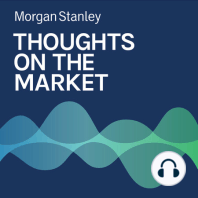3 min listen

Vishy Tirupattur: Implications of the Treasury Market Selloff
Vishy Tirupattur: Implications of the Treasury Market Selloff
ratings:
Length:
4 minutes
Released:
Oct 25, 2023
Format:
Podcast episode
Description
The rise in Treasury yields, among other factors, has caused significantly tighter financial conditions. If these conditions slow growth in the fourth quarter, another rate hike this year seems unlikely.----- Transcript -----Welcome to Thoughts on the Market. I am Vishy Tirupattur, Morgan Stanley's Chief Fixed Income Strategist. Along with my colleagues, bringing you a variety of perspectives, I will be talking about the implications of the continued selloff in the Treasury market. It's Wednesday, October 25th at 10 a.m. in New York. The grueling selloff in U.S. treasuries that began in the summer continues, most notably in the longer end of the yield curve. The ten year Treasury yield breached 5% on Monday, a level not seen since 2007 and an increase of about 125 basis points since the trough in July. Almost all of this move higher in the ten year yield has occurred in real yields. In our view, the Treasury market has honed its reaction to incoming data on the hawkish reaction function that the FOMC communicated in its September meeting, which was subsequently reiterated by multiple Fed speakers. Over the last several weeks, the asymmetry in the market's reaction to incoming data has been noteworthy. Upside surprises growth have brought up sharp increases in long end yields, while downside surprises inflation have met with muted rallies. To us, this means that for market participants, upside surprises to growth fuel doubts whether the pace of deceleration inflation is sustainable. In this context, it is no surprise that upside growth surprises have mattered more to long in yields than downside inflation surprises. We've indeed seen a spate of upside surprises. The 336,000 new jobs in the September employment report were nearly double the Bloomberg survey of economists. Month over month changes in retail sales at 0.7% were more than double the consensus expectation of about 0.3%, and triple if you exclude auto sales. We saw similar upside surprises in industrial production, factory orders, building permits as well. The rise in Treasury yields has further implications. The spike has contributed significantly to tighter financial conditions. As measured by Morgan Stanley Financial Conditions Index, conditions have tightened by the equivalent of about three 25 basis point hikes in the policy rate since the September FOMC meeting. As Morgan Stanley's Chief Global Economist Seth Carpenter highlighted, the implications of tighter financial conditions for growth and inflation depend critically on whether the tightening is caused by exogenous or endogenous factors. A persistent exogenous rise in rates should slow the economy, requiring the Fed to adjust the path of policy rates lower over time to offset the drag from higher rates. If instead, the higher rates on an endogenous reaction, reflecting a persistently stronger economy driven by more fiscal support, higher productivity or both, the Fed may not see the need to adjust its policy path lower. We lean towards the formal explanation, than the latter. In our view, it is unlikely that the third quarter strength in growth will persist. In fact, third quarter consumer spending benefited from large one off expenditures. Combine that with the expiration of student loan moratorium, we think will weigh heavily on real personal consumption in the fourth quarter and by extension, on economic growth. Tighter financial conditions driven by higher long end yields will only add to this drag. Therefore, we expect incoming data in the fourth quarter to show decelerating growth, which we expect will lead to a reversal of the recent yield spikes driven by term premiums moving lower. The subtle shift in the tone of Fed speak over the past two weeks suggests a similar interpretation, indicating a waning appetite for an additional hike this year in the wake of tighter financial conditions while retaining the optionality for future hikes. They think that the yield curve is doing the job of the Fed. This
Released:
Oct 25, 2023
Format:
Podcast episode
Titles in the series (100)
Mike Wilson: How Confident Are U.S. Businesses in the Economy? by Thoughts on the Market